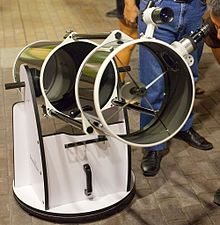Telescopic tube

The tube of a telescope ( Latin: tubus, tube ) is the cylindrical tube in which the lenses are attached and which are used to keep away the disturbing stray light. Aiming devices and other auxiliary devices can be attached to the outside of the tube. In the case of fixed telescopes (observation and astronomical telescopes), the tube carries pipe rings as a connection to the telescope mount .
Tube of lens telescopes
The name tube refers primarily to lens telescopes , where the tube is clearly visible and the lens is attached to the front . The rear end with the eyepiece usually has a smaller diameter and can be moved for focusing ( focuser ). The tube is blackened matt inside and equipped with dark circular apertures that minimize light reflections. Outside it is usually bright to reduce the warming caused by solar radiation.
Classic refractors at the turn of the century observatories, some of which are over ten meters long, assign many other functions to the telescope tube , as can be seen in the picture: In addition to the finder telescope, often the holder for an astrograph (plate camera) and its operation a parallel mounted guide telescope for precise tracking during exposure, flexible shafts for fine movement of the two mounting axes and an eyepiece extractor for connecting spectroscopes , self-registering micrometers and other accessories. For easier maneuverability (which should be possible with one hand even with instruments weighing several tons), a sophisticated system of counterweights is often attached, which can be adapted to the accessories installed.
Reflecting telescopes

In astronomical reflector telescopes , the tube is not always made continuous, but can be replaced by a grid construction - especially in large telescopes and Dobsonian telescopes . However, there is always a tube attachment directly on the main mirror . Smaller reflector telescopes (such as the widely used eight-inch models ) always have a continuous tube if the eyepiece is behind the pierced main mirror (catadioptric Cassegrain telescope ) or if they have a corrector plate in front ( Schmidt-Cassegrain and similar systems).
The tube can be extended to the front in the form of a dew cap , which prevents fogging due to nightly cooling .
The tube material used for small self-assembly telescopes is usually strong cardboard or plastic tube , from the six to eight-inch model thin sheet steel or carbon fiber . For reasons of weight, light metal is also used today for larger giant telescopes .